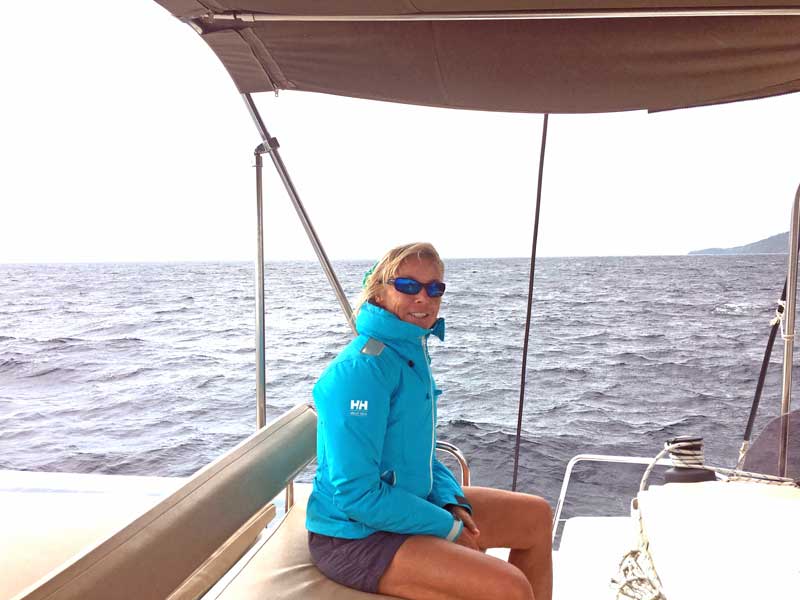One woman's solution to cruising: buying a trailerable boat.

I hate Zoom. Whenever another person suggests a “virtual… anything,” my slappin’ arm gets twitchy. Virtual means virtually not happening. But since it’s been nearly impossible to plan anything real for the past year, my normal 60 percent of time on the road or on a boat was cut way short. To keep some semblance of normalcy, I’ve spent my time driving—everywhere. I’ve named these outings Carcations as in vacations in a car. I started in April 2020 and I’m still behind the wheel when I’m not at a computer screen.
It has given me time to contemplate human nature and how weird we are. A prime example is the explosive growth in certain industries that were propelled by the pandemic. Boating was one of them. Humans all over the globe (not just in the US) decided that their escape valve was a boat, and the recreational marine industry took off as it hasn’t in decades. Dealers haven’t been able to keep boats in stock. The same thing happened with RVs and campers. Even I was tempted to get a van and go see the country.
Then, it occurred to me. Rather than an RV, why not buy a boat that could be trailered (say 27-32 feet) and pulled to the four corners of the US? I could use it as an RV on the trailer while in transit and put it in the water wherever I arrived to keep exploring—up to Alaska, down to Mexico, over to Florida and the Bahamas, and maybe even the Great Loop via the inland waterways. Try doing that with an RV.
With this plan, I’d mostly be in the US except for checking in and out of Canada, Mexico, and the Bahamas. It could take two years (two summer and two winter seasons), or it could be done piecemeal by leaving the tow vehicle and boat on the hard somewhere not too far from home.
This idea took root as I looked around and realized I’d mostly be doing this on my own. There’s much to figure out so this is the overview and first installment of a series on how to cruise without having to sell your house, buy a sailboat, find a first mate, and cross oceans. (Full disclosure: that was my plan a decade ago, but life changed.) Now I’m figuring out how to scratch that cruising itch within my means and doing it solo. That last part is especially tricky as I’m going to have to address issues on my own: all things mechanical, electrical, safety, security, and even the heavy lifting to be done by myself. But there’s nothing like a project to keep my OCD brain working like mad.

The benefits are obvious: Millions of tourists normally flock to the US to see this great country, and most of us haven’t really visited or appreciated our own back yard. There’s much more to the US than the major cities and the beaches of the East and West coasts. Also, being within a flight of home means you can still work or address family issues. Finally, a small boat gets you much farther than a big camper.
First thing’s first in this series: we need to identify the kind of boats that would serve well in this scenario and figure out what tow vehicle could do the job. Logistics are a challenge between towing permits, realistic distances to cover, security issues for traveling solo or as a couple, range and fuel considerations both on land and sea, pets aboard, etc. We’ll discuss that in the next installments.
Other pieces of the puzzle include the outfitting of the boat and vehicle and the necessary ancillary equipment. Having done this outfitting once already with a 50-foot sailboat, I can say it’s mindboggling but that’s a part of it as well. Keep it simple, keep it accessible.
Next, we’ll discuss route planning, seasons for transit, and opportunities along the way. There may be time to explore the Chesapeake, the Great Lakes, Lake Tahoe, Lake Powell, and other waterways as we move from one part of the country to another and they deserve a thorough exploration themselves.
Finally, I’d like to delve a little deeper into each of the targeted four corners. We could start in the Pacific Northwest and a bit of Canada. Then there’s Mexico which beckons with the promise of the Sea of Cortez that was called the “Aquarium of the World” by Jacques Cousteau. Florida is a great winter haven, and you can jump down to the Dry Tortugas, Cuba, or out to the hundreds of islands in the Bahamas. Finally, why not explore the ICW up through the Chesapeake, north to Rhode Island and Maine, and even inland via the St. Lawrence seaway? Heck, if you make it that far, just head through the Great Lakes and down the middle of the country back to the Gulf of Mexico.
The idea is to do the northern destinations in the spring/summer and the southern ones in the fall/ winter. A realistic pace and a curious heart would keep anyone busy for two years at the very least, but it’s an open itinerary to fit anyone’s timeline and budget.
So, if you’re up for it, let’s see what this would take in terms of planning. If nothing else, it’ll give you lots to think about when you’re driving somewhere or Zooming to nowhere.
By Zuzana Prochazka